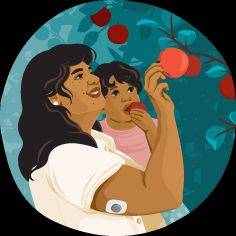You may be able to get more vitamin D by increasing your time in the sunlight, taking a supplement, and eating certain foods, including mushrooms.
Vitamin D is an essential nutrient that your body needs for many vital processes, including building and maintaining strong bones. Not getting enough vitamin D may lead to certain symptoms or complications, such as fatigue and bone weakening.
Here are some possible ways to increase your vitamin D levels.
Vitamin D is often referred to as “the sunshine vitamin” because the sun is one of the best sources of this nutrient.
Your skin hosts a type of cholesterol that functions as a precursor to vitamin D. When this compound is exposed to UV-B radiation from the sun, it becomes vitamin D.
The amount of vitamin D your body can make depends on several variables:
- Skin tone: People with dark skin tones need to spend more time in the sun to produce vitamin D than those with light skin tones. This is because dark skin has more melanin, a compound that may slightly inhibit vitamin D production.
- Age: As you age, vitamin D production and metabolism in your skin become less efficient.
- Geographical location: The closer you live to the equator, the more vitamin D your body will be able to produce year-round because of your physical proximity to the sun’s rays.
- Sunscreen and clothing: Certain types of clothing and sunscreen can also hinder vitamin D production. While it’s vital to protect yourself from skin cancer by avoiding overexposure to sunlight, it may take
only a few minutesTrusted Source of unprotected sun exposure for your body to start producing vitamin D.
Fatty fish and seafood are among the richest natural food sources of vitamin D.
In fact, a 3-ounce serving of salmon may provide up to
The exact vitamin D content of seafood may vary depending on the type and species.
Other kinds of fish and seafood rich in vitamin D include:
- tuna
- mackerel
- oysters
- shrimp
- sardines
- anchovies
Outside of beverages, mushrooms are the only vegetarian source of vitamin D.
Vitamin D content depends on the type of mushroom. Mushrooms treated with UV light also have greater vitamin D content than untreated mushrooms.
Research from 2024 notes that 4 servings a week of 75 grams (about 2.5 ounces) of UV-treated button mushrooms may be sufficient to meet the dietary RDI.
Always take care to positively identify wild mushrooms or purchase them from a trusted supplier — such as a grocery store or farmer’s market — to avoid exposure to poisonous varieties.
Egg yolks are another source of vitamin D that you can easily add to your routine. Like many other natural food sources, yolks have variable vitamin D content.
According to the Office of Dietary Supplements, one large scrambled egg contains around
Because few foods
Keep in mind that the availability of vitamin D fortified foods varies by country, and the amount added to foods may differ by brand and type.
Some commonly fortified goods include:
- cow’s milk
- plant-based milk alternatives like soy, almond, and hemp milk
- orange juice
- ready-to-eat cereals
- certain types of yogurt
- tofu
If you’re unsure whether a particular food has been fortified with vitamin D, check its ingredients list.
For some people, taking a vitamin D supplement may be the best way to ensure adequate intake.
Vitamin D exists in two main biological forms: D2 (ergocalciferol) and D3 (cholecalciferol). Typically, D2 comes from plants and D3 from animals.
The
Additionally, it’s important to purchase high quality supplements that have been independently tested. Some countries, such as the United States, don’t regulate nutritional supplements, which can negatively impact supplement quality.
It’s best to choose supplements tested for purity and quality by a third party, such as:
- the U.S. Pharmacopeia (USP)
- Informed Choice
- ConsumerLab.com
- Banned Substances Control Group (BSCG)
Dosage
Vitamin D supplements vary in dosage, and the amount you need depends on your current vitamin D levels.
For most healthy adults, the Endocrine Society recommends a daily dose of
However, you may need a larger dose in certain circumstances, such as if your current levels are very low or you have limited exposure to sunshine.
For this reason, it’s ideal to have a medical professional test your vitamin D levels to ensure you’re taking the appropriate dose.
Vegan supplement options
The majority of vitamin D supplements are derived from animal sources — and thus aren’t ideal for vegans. However, a few vegan D supplement options exist.
Because vitamin D2 is plant-derived, D2 supplements are typically vegan-friendly and widely available.
Vegan D3 is significantly less common than D2 but can be made from lichens. You may be able to find vegan D3 supplements in specialty health stores or online.
Lamps that emit UV radiation may also boost your vitamin D levels, but more research is necessary to understand their exact benefits and safety.
When exposed to UV-B radiation from the sun, your skin can produce its own vitamin D. UV lamps mimic the action of the sun and may be helpful if sun exposure is limited due to geography or time indoors.
Safety is an important concern with these devices, as too much exposure could burn your skin. Before trying a UV lamp, talk with your doctor to determine how long you should use it.
Vitamin D is an essential nutrient. You can boost your levels by getting more sun exposure, eating foods rich in vitamin D, or taking supplements.
If you suspect your vitamin D levels are low, consult a health professional to have them checked.






